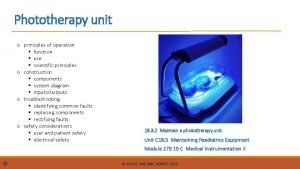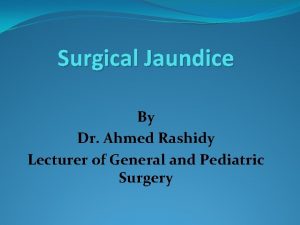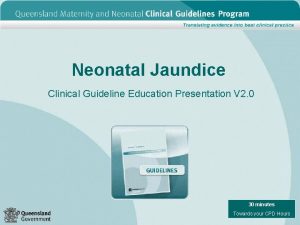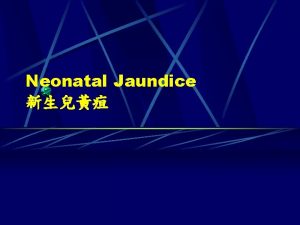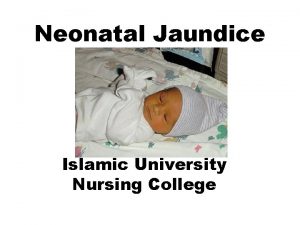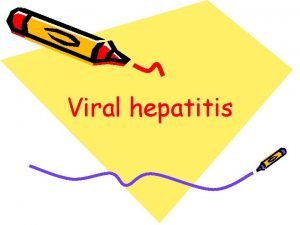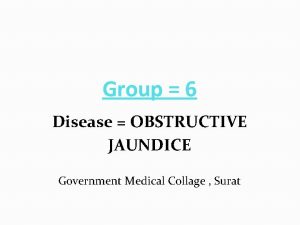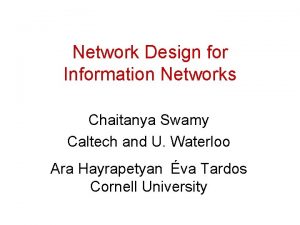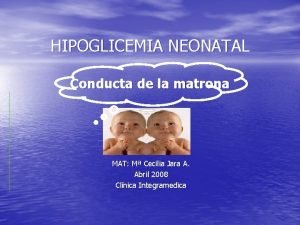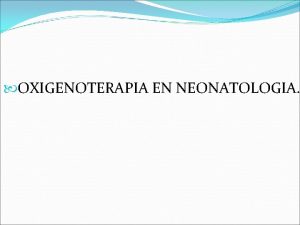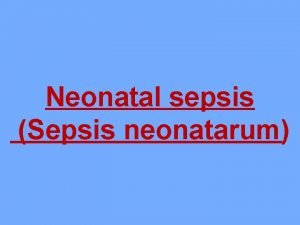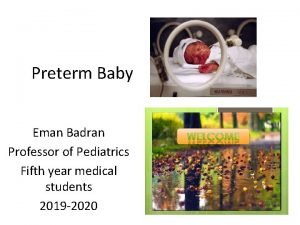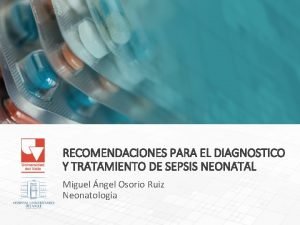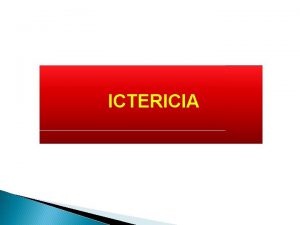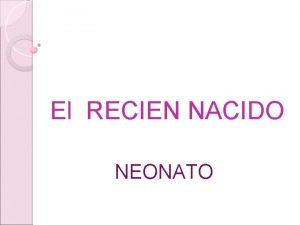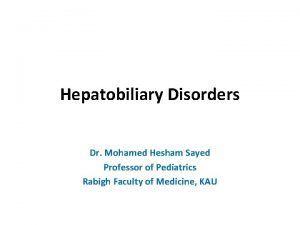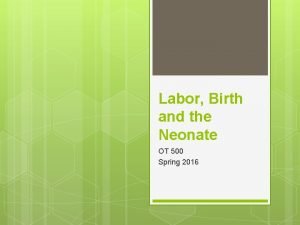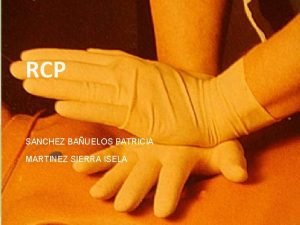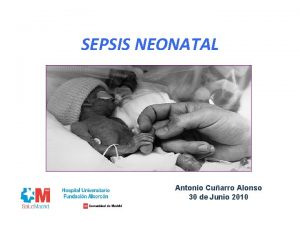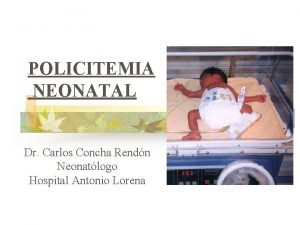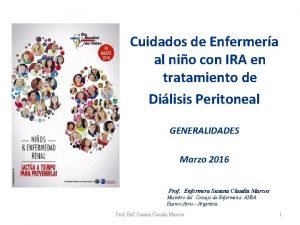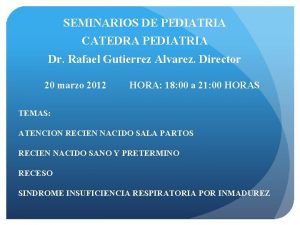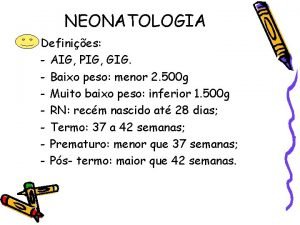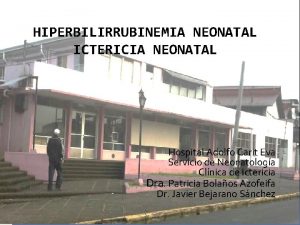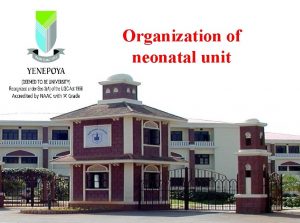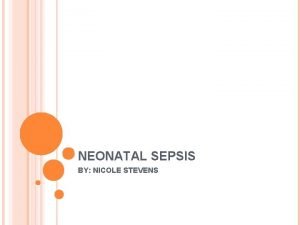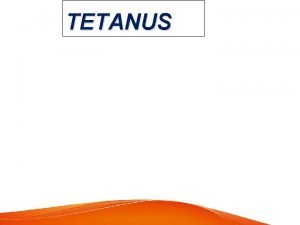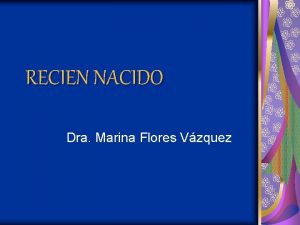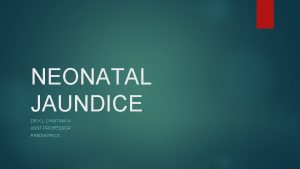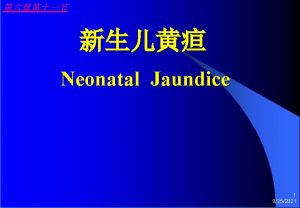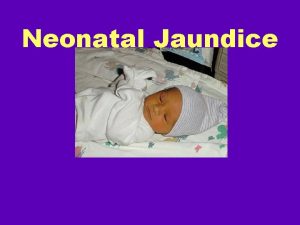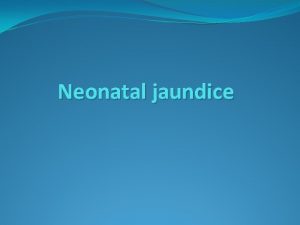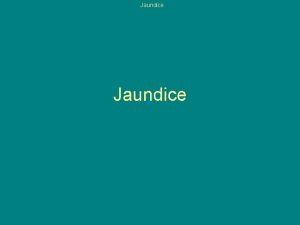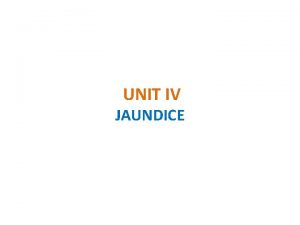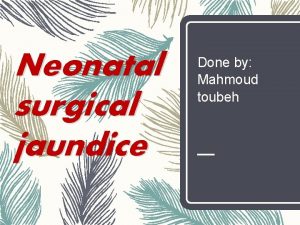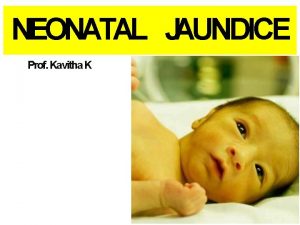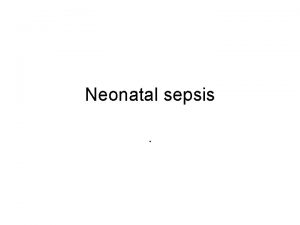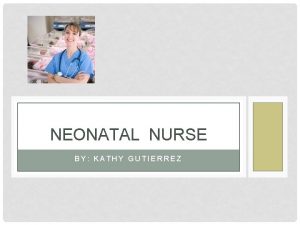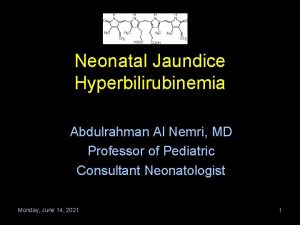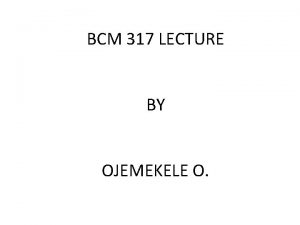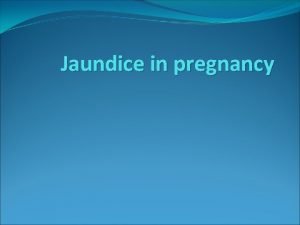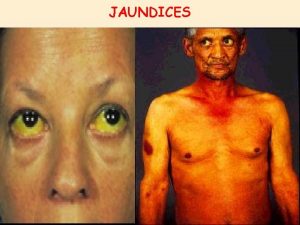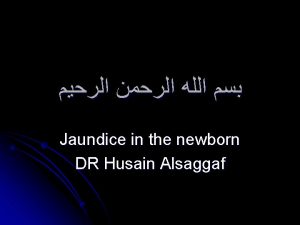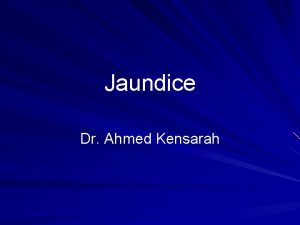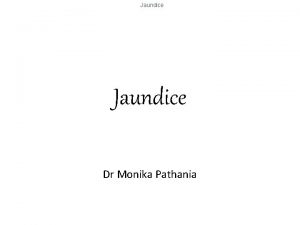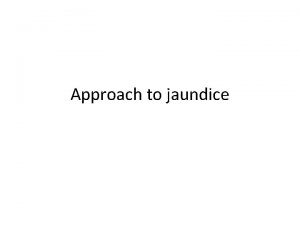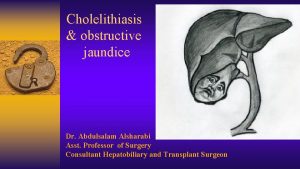NEONATAL JAUNDICE DR K L CHAITANYA ASST PROFESSOR




































- Slides: 36

NEONATAL JAUNDICE DR. K. L. CHAITANYA ASST. PROFESSOR PAEDIATRICS

What is the Neonatal Jaundice? Neonatal Jaundice(also called Newborn jaundice) is a condition marked by high levels of bilirubin in the blood. The increased bilirubin cause the infant's skin and whites of the eyes (sclera) to look yellow.

N J 3 Neonatal Jaundice Visible form of bilirubinemia ›Adult sclera >2 mg / dl ›Newborn skin >5 mg / dl Occurs in 60% of term and 80% of preterm neonates However, significant jaundice occurs in % of term babies Teaching Aids: 6


Special characteristic in neonates • 1. More billirubin produced • Much more Hemolysis • The life-length of hemolysis(70~80)

Special characteristic in neonates • 2. The low capability of albumin on unconjugated billirubin transportation • acid intoxication • Less albumin in neonates

Special characteristic in neonates • 3. The low capability of heptatocyte • Less Y protein and Z protein • The primary development of Hepato-enzyme system • Easy-broken hepato-enzyme system • After-born, the blood glucose level is very low.

Special characteristic in neonates • 4. High workload of the hepato-enteric circulation • Less bacterial • Low enzymatic activity in intestine • High level of billirubin in meconium

A little exam Increased rbc’s Shortened rbc lifespan Immature hepatic uptake & conjugation Increased enterohepatic Circulation

Grading of extent of jaundice 2

N J 1 1 Clinical assessment of jaundice Area of body mg/dl Bilirubin levels Face 4 -8 Upper trunk 5 -12 Lower trunk & thighs 8 -16 Arms and lower legs 11 -18 Palms & soles > 15 Teaching Aids:

N J 1 2 Physiological jaundice Characteristics Appears after 24 hours Maximum intensity by 4 th-5 th day in term & 7 th day in preterm Serum level less than 15 mg / dl Clinically not detectable after 14 days Disappears without any treatment Note: Baby should, however, be watched for worsening of jaundice Teaching Aids:

N J 1 3 Pathological jaundice Appears within 24 hours of age Increase of bilirubin > 5 mg / dl / day Serum bilirubin > 15 mg / dl Jaundice persisting after 14 days Stool clay / white colored and urine staining clothes yellow Direct bilirubin> 2 mg / dl Teaching Aids:

N J 1 4 Causes of jaundice Appearing within 24 hours of age Hemolytic disease of NB : Rh, ABO Infections: TORCH, malaria, bacterial G 6 PD deficiency Appearing between 24 -72 hours of life Physiological Sepsis Polycythemia Concealed hemorrhage Intraventricular hemorrhage Increased entero-hepatic circulation Teaching Aids:

N J 1 5 Causes of jaundice After 72 hours of age Sepsis Cephalhaematoma Neonatal hepatitis Extra-hepatic biliary atresia Breast milk jaundice Metabolic disorders Teaching Aids:

N J 1 6 Common causes in India Physiological Blood group incompatibility G 6 PD deficiency Bruising and cephalhaematoma Intrauterine and postnatal infections Breast milk jaundice Teaching Aids:

N J 1 7 Approach to jaundiced baby o birth weight o gestation and postnatal age o Assess clinical condition (well or ill) physiological or pathological o Look for evidence of kernicterus* in deeply jaundiced NB o *Lethargy and poor feeding, poor or absent Moro's, opisthotonus or convulsions Teaching Aids:

N J 1 8 Workup Maternal & perinatal history Physical examination Laboratory tests (must in all)* ›Total & direct bilirubin* ›Blood group and Rh for mother and baby* ›Hematocrit, retic count and peripheral smear* ›Sepsis screen ›Liver and thyroid function ›TORCH titers, liver scan when conjugated hyperbilirubinemia Teaching Aids:



N J 2 1 Management Rationale: reduce level of serum bilirubin and prevent bilirubin toxicity Prevention of hyperbilirubinemia: early feeds, adequate hydration Reduction of bilirubin levels: phototherapy, exchange transfusion, drugs Teaching Aids:

N J 2 2 Principle of phototherapy Native bilirubin Insoluble 450 -460 nm Photo of light isomers of bilirubin Soluble Teaching Aids:


N J 2 4 Phototherapy equipment White light tubes 6 -8*/ 4 blue light tubes Cradle or incubator Eye shades *May use 150 W halogen bulb Teaching Aids:

N J 2 5 Phototherapy Technique Perform hand wash Place baby naked in cradle or incubator Fix eye shades Keep baby at least 45 cm from lights, if using closer monitor temperature of baby Start phototherapy Teaching Aids:

N J 2 6 Phototherapy Frequent extra breast feeding every 2 hourly Turn baby after each feed Temperature record 2 to 4 hourly Weight record- daily Monitor urine frequency Monitor bilirubin level Teaching Aids:

Key point in the practical execution of phototherapy 2 - distance between the skin and light source. 3 -when used spotlight , the infant is placed in centre . 4 - routinely add 10 -15% extra fluid. 5 - timing of follow -up S. B testing must be individualized. NJ - 27 1 -The infant should be naked except for diaper , eye to be covered

NJ - 28

N J 2 9 Side effects of phototherapy Increased insensible water loss Loose stools Skin rash Bronze baby syndrome Hyperthermia Upsets maternal baby interaction May result in hypocalcemia Teaching Aids:

N J 3 0 Choice of blood for exchange blood transfusion ABO incompatibility ›Use O blood of same Rh type, ideal O cells suspended in AB plasma Rh isoimmunization ›Emergency 0 -ve blood Ideal 0 -ve suspended in AB plasma or baby's blood group but Rh -ve Other situations ›Baby's blood group Teaching Aids:

DRUGS Phenobarbitone- increases y&z ligandin receptors-induces liver enzymesincreases conjugation Metalloporphyrins- tin&zinc-inhibits heme oxygenase IVIG- inhibits heamolysis Oral agar &cholestyramine- decreases entero hepatic circulation Albumin infusions-increases bilirubin binding

Kernicterus is damage to the brain centers of infants caused by increased levels of unconjugated-indirect bilirubin which is free (not bound to albumin).

N J 3 3 Prolonged indirect jaundice Causes Crigler Najjar syndrome Breast milk jaundice Hypothyroidism Pyloric stenosis Ongoing hemolysis, malaria Teaching Aids:

N J 3 4 Conjugated hyperbilirubinemia Suspect High colored urine White or clay colored stool Caution Always refer to hospital for investigations so that biliary atresia or metabolic disorders can be diagnosed and managed early Teaching Aids:

N J 3 5 Conjugated hyperbilirubinemia Causes Idiopathic neonatal hepatitis Infections -Hepatitis B, TORCH, sepsis Biliary atresia, choledochal cyst Metabolic -Galactosemia, tyrosinemia, hypothyroidism Total parenteral nutrition Teaching Aids:

THANK YOU
 Parts of phototherapy unit
Parts of phototherapy unit Biliary astresia
Biliary astresia Bilirubin chart
Bilirubin chart Differential diagnosis of jaundice in pediatrics
Differential diagnosis of jaundice in pediatrics Nursing diagnosis for neonatal jaundice
Nursing diagnosis for neonatal jaundice Neonatal jaundice
Neonatal jaundice Obstructive jaundice lab diagnosis
Obstructive jaundice lab diagnosis Chakravarty r. alla chaitanya
Chakravarty r. alla chaitanya Chaitanya charan das
Chaitanya charan das Chaitanya neet
Chaitanya neet Ara hayrapetyan
Ara hayrapetyan Sri krishna caitanya prabhu nityananda
Sri krishna caitanya prabhu nityananda Promotion from associate professor to professor
Promotion from associate professor to professor Hemoglucotest en neonatos
Hemoglucotest en neonatos Oxigenoterapia halo
Oxigenoterapia halo Storch infection
Storch infection Preterm classification
Preterm classification Sepsis temprana
Sepsis temprana Ictericia neonatal clasificacion
Ictericia neonatal clasificacion Reflejos en el período neonatal
Reflejos en el período neonatal Necrotizing enterocolitis symptoms
Necrotizing enterocolitis symptoms Neonatal liver failure
Neonatal liver failure Circulação neonatal
Circulação neonatal Apgar score of 7
Apgar score of 7 Neonatal reflexes
Neonatal reflexes Dope reanimacion neonatal
Dope reanimacion neonatal Cuarro
Cuarro Formula de oski y naiman
Formula de oski y naiman Nanda hipertension
Nanda hipertension Esfuerzo respiratorio neonatal
Esfuerzo respiratorio neonatal Aig pig gig
Aig pig gig Curva bilirrubina fototerapia
Curva bilirrubina fototerapia Organization of neonatal unit
Organization of neonatal unit Psychiatric nursing diagnosis
Psychiatric nursing diagnosis L
L Tetanus
Tetanus Clasificacion de kramer ictericia
Clasificacion de kramer ictericia
